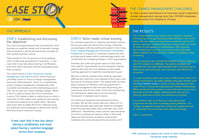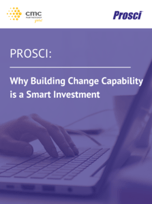Probably the most common question I am asked by clients once they are introduced to the value of Change Management is, "How much is this going to cost me?"
Of course, there is a budget process that may be administered projecting specific project costs to include people power, time allocations, communications, materials, etc. But the true answer is, "It is not going to cost you any more money than you are already going to spend."
You see, the cost of managing change is not incremental, it is inevitable.
In the end, your project teams are either doing the work to help people to adopt and use the change, or they are not. If they are, it is simply a matter of pulling out those items that are focused on the people side of change and allocating them to Change Management.
In the more likely scenario that they are not doing all the required work to help people adopt and use the change, there are two other possible results:
- You will launch a separate project following the change project to drive adoption and usage, or...
- You will not launch a separate project, and the organisation will not achieve its return on investment
Either way, the cost is incurred.
The first result is quite common. We see it all the time in our Prosci® Certified Change Management Practitioner Programme, delivered by CMC Global. As part of the three-day programme, participants bring a project to work with to apply the Prosci Methodology, tools, and templates they learn. Each session, at least one participant will introduce a project in a last ditch effort to drive adoption for a change that has already been implemented but did not get the take up from the necessary people in its initial efforts. They now have a whole new project, often with a new team because the previous team has moved on. This result is the worst-case scenario because they now have a failed result that will have additional costs that far exceed the costs of doing Change Management from the beginning.

So, why is poorly managing change costly?
Anyone who has been in the corporate world for some time knows that companies don't just move on from failed projects. They almost always make a second or even a third attempt which, even if they succeed, the return will be less than expected and, more importantly, late in coming. Herein, lie the advantages of planned and well executed change.
I once consulted with a company that was on their third attempt to properly implement SalesForce. In the first two efforts, they failed to get the sales team to utilise the system. But, they kept trying over the course of a decade. Each effort required them to purge the existing, outdated data, redesign the user interface, and retrain the sales and marketing team. Only on the third attempt, after introducing Change Management to the project, was the result positive. It only took 11 years for them to start to see the results of their efforts. This means 11 years of licence fees, three rounds of implementation costs, and the delayed return one investment (i.e. sales revenue). In the end, after conducting a cost-benefit analysis, we calculated that the total cost of this change was around 4.5 million for a company that only had $10 million in revenue per year.
That said, we can consider them lucky because this group finally did achieve some results. Most do not. And here the cost of not doing Change Management is incurred because not just in the present but also in the future. Organisations that fail to implement change not only lose their current investment, but they may also damage the potential of future projects. According to Prosci® research, one of the greatest factors leading to change resistance is a history of failed change. People who supported the past projects that failed are much less likely to support future projects, and such resistance raises the costs of implementing new change. So, failing to cover the minor, incremental Change Management administrative costs on a project today may increase the costs for future projects.
The conclusion from all this is what I ask clients, "In the end, we pay the cost anyway, why not do it right the first time? Why not do it with intent? And why not get it right the first time?"
After all, Change Management is inevitable.
If you'd like to speak to one of the team members here at CMC about how to kick-off your Change Management journey, please get in touch with us. We've worked with hundreds of organisations globally to help them build their change capability. Read our case studies to find out more.
Featured Resources:
CMC Case Studies Why Building Change 6 Tactics for Growing Capability is a Smart Enterprise Change Investment (New) Capability





